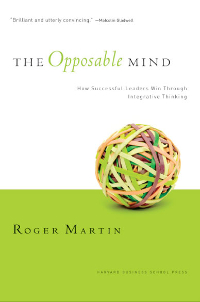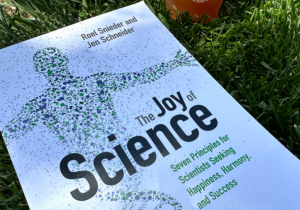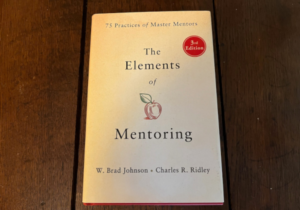Why you should read The Opposable Mind
 For fifteen years prior to this book’s publication, author Roger Martin studied successful leaders, interviewing more than fifty of them for up to eight hours at a time, trying to find a pattern to their success. The pattern he discovered was what he calls “integrative thinking.” Such thinkers have the predisposition and capacity to hold two diametrically opposing ideas in their heads. And then, without panicking or simply settling for one alternative or the other, they’re able to produce a synthesis that is superior to either opposing idea.
For fifteen years prior to this book’s publication, author Roger Martin studied successful leaders, interviewing more than fifty of them for up to eight hours at a time, trying to find a pattern to their success. The pattern he discovered was what he calls “integrative thinking.” Such thinkers have the predisposition and capacity to hold two diametrically opposing ideas in their heads. And then, without panicking or simply settling for one alternative or the other, they’re able to produce a synthesis that is superior to either opposing idea.
Martin breaks this way of thinking into four identifiable differences from conventional thinking: First, when integrative thinkers face a problem, they include as many “salient features,” or points of consideration, as possible. They welcome the mess, because it assures them that they haven’t edited out features necessary to the contemplation of the problem as a whole. This is critical for all the steps, which rely on looking at problems as a whole rather than as component parts. Relationships between parts of a problem are multidirectional and nonlinear (considering these is the second step of integrative thinking), and considering these relationships and components as a whole avoids the trap of coming up with the perfect solution that’s impossible to execute, or which will solve one part of the problem but worsen another (yep, that’s the third step). Finally, rather than settling for one option or another, integrative thinkers ?search for creative resolution of tensions, or the best of both worlds, even if it means delays and rework at the last minute.
Martin illustrates this process with a case study of the Four Seasons Hotel, whose founder refused to settle for either large, lavishly-appointed but impersonal hotels or small, cozy motels that lacked state-of-the-art amenities, instead creating a business model that provides both. Other examples discussed include the Institute for OneWorld Health, whose founder decided it was “unacceptable!” that many lethal diseases afflicting primarily the world?s poor went unacknowledged by traditional for-profit pharmaceutical companies. She filled the structural gap between companies that developed new drugs they needed to sell at high prices to recoup costs, and non-profit organizations that distributed existing drugs to the world?s poor at subsidized rates, with a not-for-profit pharmaceutical development company. Have there been instances in your career where you had to choose between the proverbial rock and a hard place? Then you need to read this book.
As Martin acknowledges, The Opposable Mind largely chronicle[s] the obvious that has been taken for granted. However, looking at the obvious from new angles and considering new salient features is the first step of integrative thinking. What better place to start than right at the beginning?
The Opposable Mind
Roger Martin
Harvard Business Review Press, 2009






0 Comments